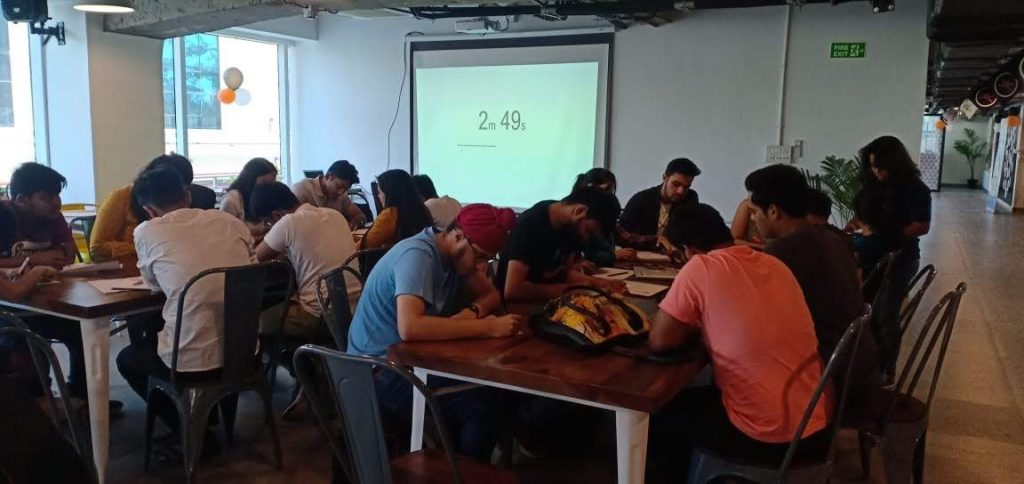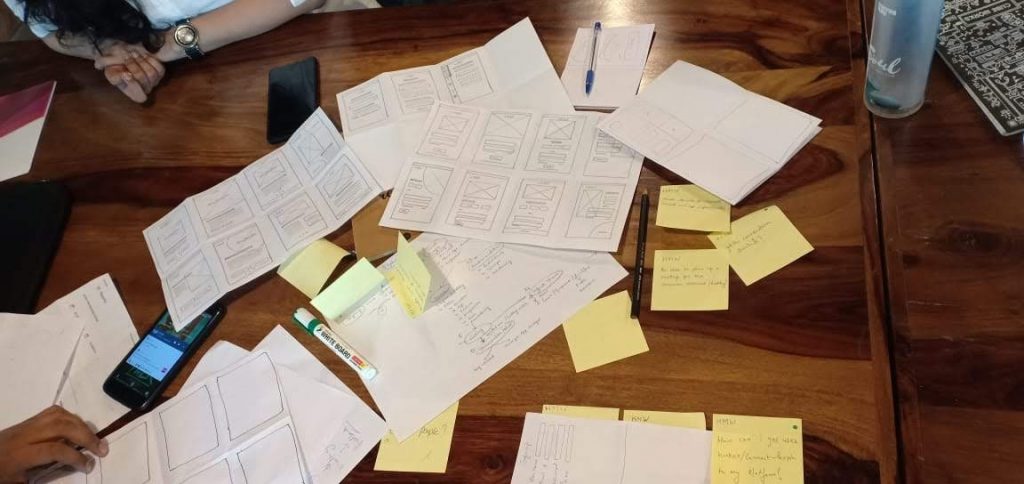Identify the problem, Get a Solution - defined, designed, prototyped and tested in a single day.
A bright sunny Sunday morning, where the day is planned to stay lazy at home, Hackr Bootcamp, an offline initiative by Hackr.io planned a full day Google Design Sprint at 91springboard, Sector-44, Gurugram considering the growing importance of Design Thinking in the Industry,
Yes!! Design motivated a lot of enthusiasts and learners to come out from their comforts on the weekend to learn about Design.
The workshop started with a presentation well conducted by Angelene, a Senior UX Designer at Gradeup & Community leader at IDF-NewDelhi. She explained about Importance of Design Thinking and What, Why and How of Google Design Sprint.
The obvious question was “So Design Sprint is Design Thinking!” Right? Well, here I have tried to summarise the whole workshop, hope you find it useful.
The Difference between Design Thinking & Design Sprint
Design Thinking
“Design thinking is a human-centred approach to innovation that draws from the designer’s toolkit to integrate the needs of people, the possibilities of technology, and the requirements for business success.”—TIM BROWN, CEO OF IDEO
Design Thinking is the learning of philosophy, thinking, and mindset of innovation and tools to build creative products. Where Design Sprint is a step by step process for building innovative and creative Products/ business model.
Design teams use Design Thinking to solve critical business problems or we also call it wicked problems. The process is carried out keeping in mind user behaviour and it's perspective about the usage of product or service, it allows us to think practically, find solutions that are usable, useful and accessible.
To read more about Design Thinking, must read: What is Design Thinking?
Design Sprint
Design Sprint is a five-day process for solving critical business problems and have been adopted by many companies now as it gives teams a shortcut to learning without building and launching a product. Google Design Sprint is introduced by Jake Knapp from Google Ventures. This methodology gets your team together in order to cut short endless debates carried for months of time to a single week that helps to come up with simple solutions to complex UX & business challenges. It saves time, helps make critical decisions fast and promotes effective collaboration. It allows you to execute an idea without carrying on expensive commitments and obtain a realistic prototype in a week’s time. Thus helping businesses save useless developing hours.
In one of the slides, she explained to build a team for the Design Sprint, A team should include one person form each department - CEO(Decision Maker), Marketing, Finance, Developer, Customer, Design and a Moderator or Facilitator.
Also, there should be a proper place to perform such design sprint and as mentioned by Jake Knapp, in one his article, One should have a dedicated space with walls of a war room as that helps to work better. Walls provide a canvas for shared note-taking and act as long term storage for work in progress.
We somehow tried to do Design Sprint at a vibrant and a room full of natural light of 91springboard. A huge table was used by teams to carry their sprint process, to paste sticky notes, and create prototypes.
Read here for more by Jake himself: Your Design Team Needs A War Room. Here’s How To Set One Up
Based on this, all the attendees were divided into two teams and each team was given a different problem statement to conduct a mini design sprint on. Angel asked the teams to choose between two Problem Definition
- Pet Adoption System
- Finding a Hobby Center in the neighbourhood
Google Design Sprint: Workshop Insights
The whole process was divided into five steps:-
- Map
- Sketch
- Decide
- Prototype
- Test
Step 1:-
Map: In the mapping phase, a team has to find a solution based on questions like
- Why are we doing this project?
- Where do we want to be in next months?
- What could be possible failures? etc
Next was-
1.Goal Setting: Goal needs to be set with long term vision, like What will product or service be in the next 10 to 15 years. Like in Pet Adoption, Goal for the long term was that No pet should be without home and care and No pet lover should find any difficulty in seeking a pet.
- Target Audience / User Persona: Define the users, who will be using the product, what kind of people will be using it?
- “How Might We” Questions: In this, all the team members of each team has to frame “How Might/ Can We...:” questions that are not too broad or too narrow like in same Pet Adoption case, HMW question can be “How Might We- adopt a pet” or “How might we - locate an adopter?”

- User Journey: In this, we make a map of a possible users User journey, from end to end. Like, if we consider creating User Journey based on one of the above questions that “HMW- adopt a pet”, we need to map user starting his journey from using How a user will use app to find a shelter home, what screens he will see, where he will click, what will be possible ways he will use to reach the right Pet Shelter home, etc
We will make all possible User Journeys based on one specific “HMW” question.

Suggested Course
Design Sprint: Create a Great Product Prototype in 5 days!
Step 2: Sketch / Scribble
Sketching is my favorite step, We were supposed to sketch possible screens for a web app based on User Journeys we defined earlier. Each Person has to sketch following the four-step process that emphasizes critical thinking over creative skills.
The four-step Sketch process:
- Notes- collect all key points, info or inspiration
- Ideas - Brainstorm and doodle rough sketch
- Crazy 8’s - try 8 different possibilities for each screen
- Solution Sketch- Finally, Sketch the final paper wireframes of all variations.
Step 3: Decide(30 Mins)- Let’s Vote
Teams internally have to vote for best solution sketched by each member and they need to pick best from the lot.
Decide one best solution to be ready for final Prototyping
Step 4: Prototype (30Mins)
Prototyping is done by cleaning all rough sketches, wireframes and creating the final prototype. This is usually done by a designer in the team because all prototypes should look clean, readable and clearly understandable.

Step 5: Presentation & Discussion(1 hr)
By the end of the day, Both the teams presented their solutions with wireframes to everyone. It was amazing to see that people had come up with such elaborate solutions in such a short time. The best part was everyone interacted with each other and we all had a good learning session together. Hopefully, the takeaways from this workshop would help everyone to conduct similar design sprints in their own workplaces.
Hope you find this interesting. If you are willing to attend Hackr Bootcamp workshops, get updates about the next workshop on-
We can’t solve problems by using the same kind of thinking we used when we created them. - Einstein

![7 Best AI Coding Assistants In 2023 [Free + Paid]](jpg/16952882603blllo1oza.jpg)
![30 Cool, Easy & Fun Python Projects + Source Code [2023]](png/1655865129yuz5v1mdab.png)

![The 14 Best TensorFlow Courses in 2023 [Free + Paid]](png/1624550510xonrryd0t0.png)
![10 Best Design Books for Design Students [Updated]](png/1642872008wcnbdsvf6q.png)
![I Ranked the Top 5 Best AI Image Generators [with Image Examples]](jpg/1682848644stltm9ynp6.jpg)




